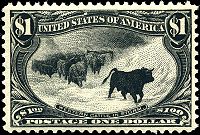
Western Cattle in Storm
Encyclopedia

Trans-Mississippi Issue
Black Bull redirects here, for the F-Zero machine, see F-Zero RacersThe Trans-Mississippi Issue, or "Trans-Miss" for short, is a set of nine commemorative postage stamps issued by the United States to mark the 1898 Trans-Mississippi Exposition held in Omaha, Nebraska...
. Western Cattle in Storm is one of nine commemorative postage stamps in the series, which marked the 1898 Trans-Mississippi Exposition
Trans-Mississippi Exposition
The Trans-Mississippi and International Exposition was a world's fair held in Omaha, Nebraska from June 1 to November 1 of 1898. Its goal was to showcase the development of the entire West, stretching from the Mississippi River to the Pacific Coast. The Indian Congress was held concurrently...
held in Omaha, Nebraska. While the entire Trans-Mississippi Issue set has been praised for its quality, the $1 stamp, also called the Black Bull, stands out from the rest.
The breed of cattle used in the issue were meant to represent the ruggedness of the American West, but actually derive from the West Highlands of Scotland. That’s because the design replicated a James McWhirter painting depicting cattle in a winter storm in the West Highlands of Scotland. This painting was copied, without the permission of the owner, Lord Blythswood, by an American cattle company as a trademark of sorts.
“McWhirter, however, was a Scot, and his painting, entitled The Vanguard, was soon discovered to have been a depiction of Scottish cattle in a storm in Scotland,” according to a company called Chicago Stamps. ”It was actually painted in a small farmhouse near the Scottish highland town of Calendar. The scene did not depict an event west of the Mississippi, but it might have been, and few really cared about this detail, for cattle were an important part of the western U.S. economy.”
This image caught the attention of the Post Office Department and Raymond Ostrander Smith, the staff designer of the Bureau of Engraving and Printing at the time, and it was adopted for the $1 design. Little did the designer know that the scene depicted was in Scotland, not the Western U.S., as was supposed. A full apology was later issued to the owner of the painting.
Printing
The nine stamps of the Trans-Mississippi series were originally to be two-toned, with colored frames surrounding black vignettes, but the Bureau of Engraving and Printing, its resources overtaxed by the needs of the Spanish-American WarSpanish-American War
The Spanish–American War was a conflict in 1898 between Spain and the United States, effectively the result of American intervention in the ongoing Cuban War of Independence...
, simplified the printing process, issuing the stamps in single colors. In all, the Bureau of Engraving and Printing produced 56,900 copies of Western Cattle in Storm. A violet-brown frame with a black vignette (center design) was planned for the $1 Western Cattle in Storm stamp. Instead, the $1 denomination was printed with black ink.
The entire printing run of Western Cattle in Storm lasted three days, from June 1–3, 1898.
Distribution
The earliest known date of delivery to postmasters of stamps of the Trans-Mississippi Issue is June 15, 1898. The assigned first day of issue was June 17. There had been considerable pre-issue publicity regarding the series, which resulted in an early rush on the initial limited supplies available at post offices. But such interest was short-lived, especially as post offices replenished their stocks, the novelty of the new stamps wore off, and speculative interest waned. On December 31, 1898, the sale of stamps to postmasters was discontinued. Afterward, an unknown quantity of unsold stamps were destroyed.Prior to the issuance of the $1 Western Cattle in Storm, only two other $1 US postage stamps had ever been printed and released to the public: the $1 Columbian Exposition stamp issued in 1893 and titled Isabella Pledging Her Jewels; and the $1 Oliver Hazard Perry issued in 1895.
Appraisal
While today Western Cattle in Storm is regarded as one of the most attractive U.S. stamps ever produced, there have been detractors. John Luff, one of the most influential philatelic writers of his day, apparently did not think much of the stamp or others in the series, according to Chicago Stamps. “The stamps are poorly conceived and executed, overloaded with ornaments, heavy in color and blurred in printing,” he wrote in 1902.But by 1933, author Ralph Kimble described the Trans-Mississippi stamps as “perhaps the most attractive set of commemoratives which we have ever had,” adding additional flattery for the $1 stamp. In 1934, Stamps magazine asked readers to vote on the most beautiful stamp in the world. The Canadian 1928 50¢ Bluenose stamp won first place with Western Cattle in Storm placing second.
Today, pristine copies of Western Cattle in Storm can sell for tens of thousands of dollars.

